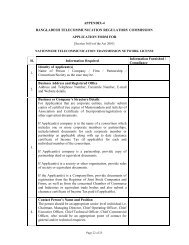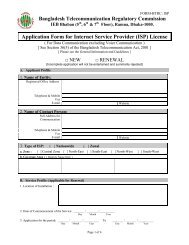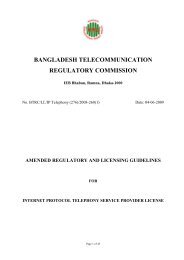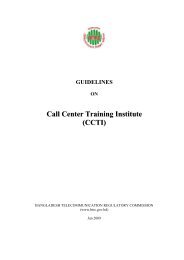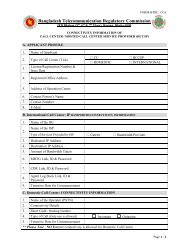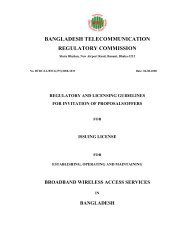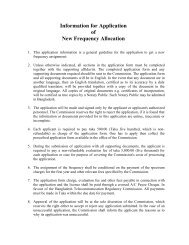BANGLADESH TELECOMMUNICATION REGULATORY ... - BTRC
BANGLADESH TELECOMMUNICATION REGULATORY ... - BTRC
BANGLADESH TELECOMMUNICATION REGULATORY ... - BTRC
You also want an ePaper? Increase the reach of your titles
YUMPU automatically turns print PDFs into web optimized ePapers that Google loves.
13. “Interconnection Exchange (ICX)” refers to switching system whch provides interconnections among<br />
the existing/future telecommunication network of the operators and allows monitoring, Lawful Interception<br />
(LI) facilities and roaming number portability.<br />
14. “International Gateways (IGWs)” are switching systems through which international voice traffic (VoIP<br />
and Clear Channel) is sent and received. IGW allows physical monitoring of the traffic flow.<br />
15. “ITU” means International Telecommunication Union;<br />
16. “License” means an authorization issued by the Commission under section 36 of the Act and Regulations<br />
issued by the Commission for establishing, operating and maintaining IGW systems and services;<br />
17. “Multi Router Traffic Grapher (MRTG)” is a tool to monitor the traffic load on network-links. MRTG<br />
generates HTML pages containing GIF images and also other formats which provide live visual<br />
representation of traffic. It allows the user to see traffic load on a network over time in graphical form.<br />
18. “Next Generation Network (NGN)” is a packet based network able to provide services including<br />
telecommunication services and able to make use of multiple broadband, QoS-enabled transport<br />
technologies and in which service related function are independent from underlying transport related<br />
technologies. It offers unrestricted access by users to different service providers. It supports generalized<br />
mobility which will allow consistent and ubiquitous provision of services to users.<br />
19. “Number Portability” is the term used to describe capability of individuals, business and organizations to<br />
retain their existing telephone number(s) and the same quality of service when switched to another local<br />
service provider.<br />
20. “NTP” means the National Telecommunication Policy, 1998 as amended from time to time;<br />
21. “Operator” means an organization or a person licensed for establishing or operating a telecommunication<br />
system or providing telecommunication service or operating a system which is the combination or more<br />
than one of those facilities.<br />
22. “PBG” means Performance Bank Guarantee from a scheduled Bank;<br />
23. “Point of Presence (POP)” means setting up of switching centre and transmission centre of appropriate<br />
capacity to provide on-demand service of prescribed quality and grade of service in a non–discriminatory<br />
manner.<br />
24. “Point of Interconnection (POI)” means the physical location at which two or more networks<br />
interconnect through switches, nodes or other facilities and offering access to the operator/service<br />
operators.<br />
25. “Packet Switching” is a method to move data around on the Internet. In packet switching, the data is<br />
broken up into chunks, attached with address and allows many people to use same line at the same time.<br />
26. “Quality of Service (QoS)” is evaluated on the basis of measures on the grade of service, calls lost due<br />
to wrong processing, bit error rate, response time, acceptable number of faults per unit subscribers served,<br />
and Mean Time To Restore (MTTR), faults carried over beyond the MTTR, etc.<br />
27. “Regulation” means, regulations made or will be made in the future by the Commission under the Act;<br />
28 of 49




